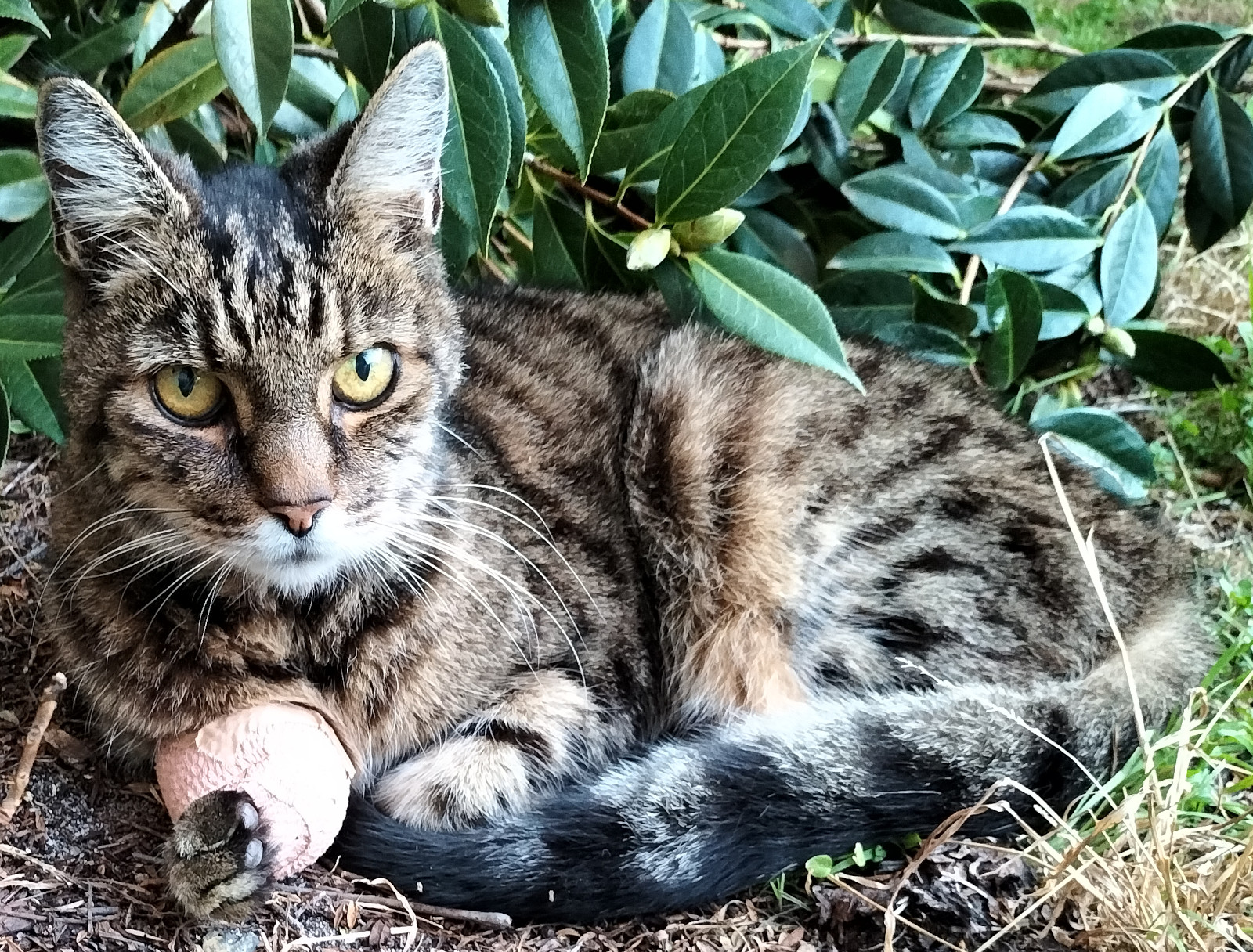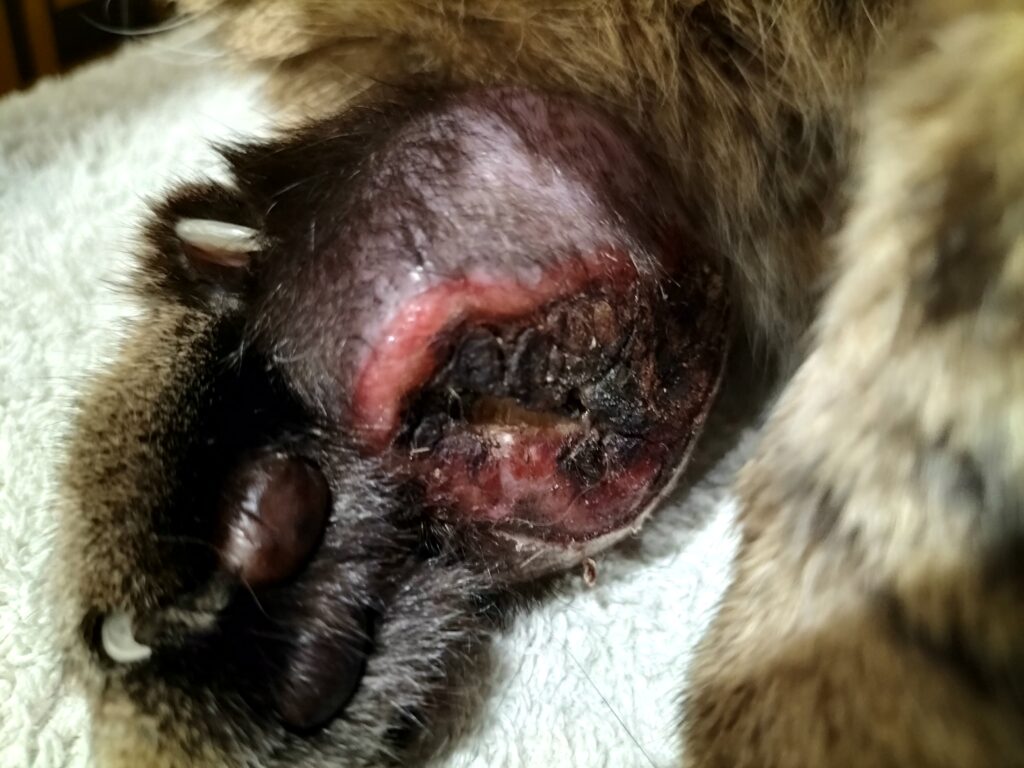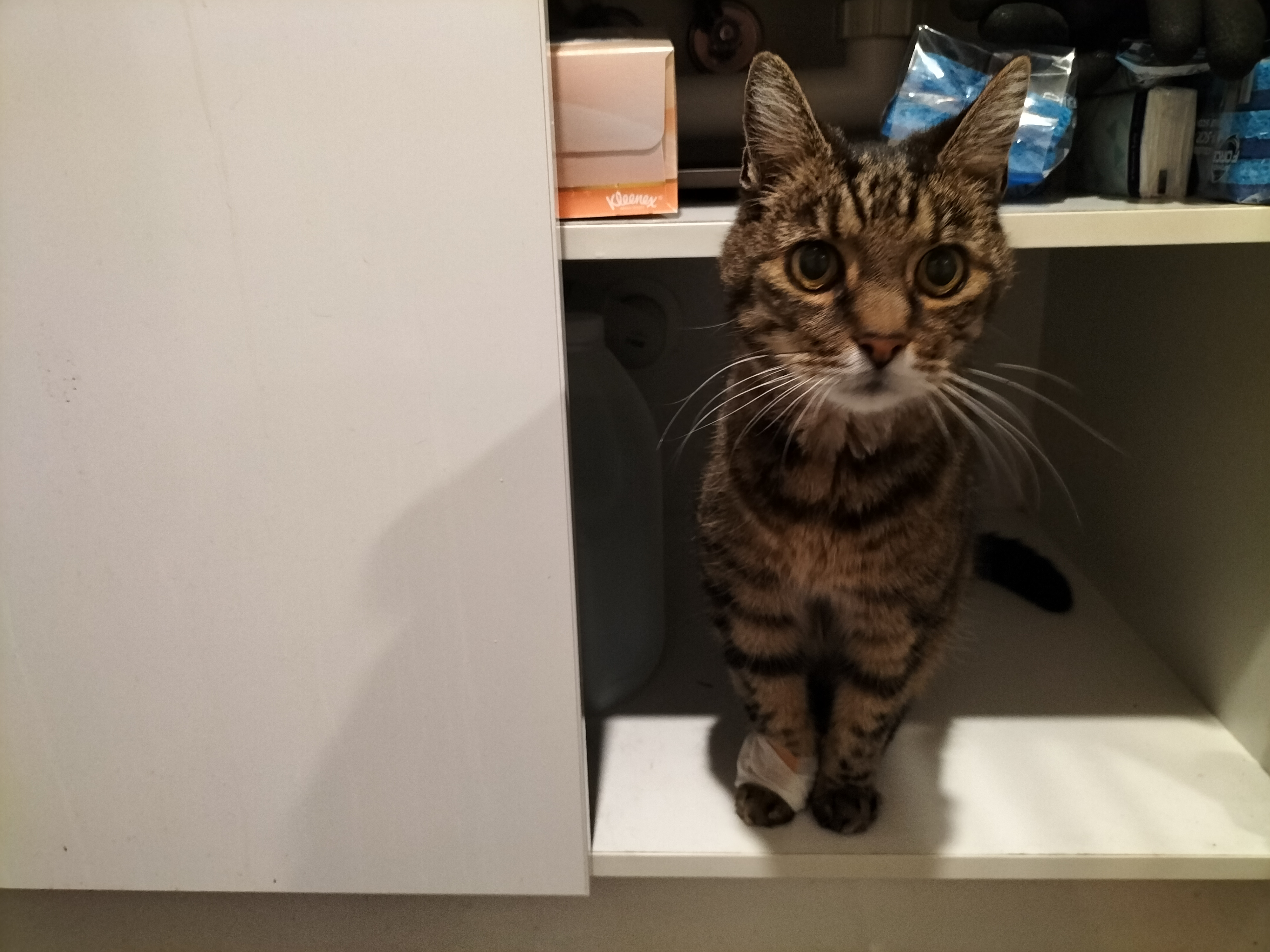
It’s a fairly common story. My 15-year-old cat has developed hyperthyroidism and has also been diagnosed with kidney disease. He was a 5.5kg cat about a year ago, but was now drinking a lot of water and has lost about 1.5kg, bringing his weight down to almost exactly 4kg.
His hyperthyroidism is being managed with Carbimazole, and blood tests have confirmed that the Carbimazole is working. He isn’t a candidate for either a thyroidectomy or radio iodine treatment, due to his kidney disease. I learnt his as I was in contact with various vets, trying to work out if I can get him a better treatment than just managing his symptoms with Carbimazole. The conclusion is that due to his kidney disease, they suspect that either treatment would result in death.
After being on Carbimazole for a couple of weeks, the cat was basically refusing to eat or would eat very little. He would walk up to his food, sniff it, and walk away. As such, blaming the Carbimazole for his lack of appetite, I took it upon myself to halve his dose to see if that would improve his appetite.
He was initially on a dose of 2.5mg twice a day (1/2 a 5mg tablet twice a day), which I reduced to approximately 1/4 of a tablet twice per day. That seemed to improve things a bit, but he still wasn’t eating well. At about the 3 week mark, I called his current vet, and told them the problem and what I’d done. Their response was that there was nothing they could dispense to help, and that if he still wasn’t eating tomorrow, to bring him back in. I wasn’t happy with this response as I already knew that there were things that could be given to cats to increase their appetite, Valium for one.
I’d done some research in the past with regard to administering Valium to the cat in question, as he would occasionally get upset after having an altercation with another cat and would get fairly vocal. stop eating, and his behaviour would change – you could tell he was upset. I found that a small dose of Valium would act a bit like a reset button, and he’d be back to normal fairly quickly.
I also found that Valium would have a few other side-effects. Firstly, he became more affectionate and wanted more attention, his appetite would increase (usually within 45 minutes of administering the Valium) and he’d walk around like he was a bit drunk for an hour or two. He’d be fairly floppy if you picked him up, and you’d have to put him back down carefully as he’d occasionally fall in a heap and hit his jaw on the floor.
While calling and e-mailing various vets to find out whether he would be suitable for either radio iodine therapy or a thyroidectomy, I came across one particular vet that informed me that there were two types of thyroidectomies and that she would like meet the cat and discuss his treatment options.
I figured that she just wanted to get a consultation fee out of me before giving me any information, but she was also the only vet that was willing to do a thyroidectomy if it was appropriate, and at this time, that was looking like it might be his only option. So I took him in to see her.
The consultation was quite productive. She had read through his medical history (15 pages to date) and went through everything relevant with me again, I think to ensure that we were both on the same page. I told her that I’d reduced his dose of Carbimazole to 1/4 of a tablet twice a day, and that he was eating better but still not eating well, and still not putting on any weight (but not losing weight either). I also mentioned that he wouldn’t eat the Hills Prescription Diet K/d food (it’s easier on his kidneys than regular cat food).
We discussed his lack of appetite, which she explained was likely due to his kidneys not filtering his blood very well anymore, so he’d probably feel a bit like he has a hangover. She explained that prior to getting his hyperthyroidism under control, he probably would have had high blood pressure and that would have meant more blood would be pumped through his kidneys, somewhat compensating for their inability to filter his blood properly. She also informed me that they can give him medication to increase his appetite – pretty much the exact opposite of what his (now sacked) previous vet had advised.
I mentioned that I’d been giving him approximately 0.8mg of Valium on occasion to get him to eat, but that even that wasn’t working as well as it used to and I wasn’t sure if I was giving him the correct dose.
She suggested that Mirtazapine would be another option and that it would also be better for his liver. I was surprised to learn that Mirtazapine could be used as an appetite stimulant, and like the Valium, I already had some at home as I was prescribed it to help manage my anxiety disorder and to help me sleep, but unlike his original vet, she advised me that they can dispense Mirtazapine for the cat if I need some.
I asked if she knew what the correct dose of Valium would be to use as an appetite stimulant. She asked her assistant to fetch “the book” and looked up the correct dose of Valium for use as an appetite stimulant: 0.2mg/kg. So considering he was 4kg at the time, I was spot on. She also informed me that there are other uses of Valium, and that the dose I’d been giving him was on the lower side, so a higher dose probably wouldn’t have caused any harm.
The result of the consultation was a plan to feed him anything that he’ll eat, try giving 1/2 a Carbimazole tablet once per day for 2-3 weeks and to give 1/4 of a 15mg Mirtazapine tablet every 3 days, then bring him back in for another blood test to see if it’s working.
Approximately 3 weeks later, I took him back to his new vet. He was weighed, heart rate checked, and they took more blood for another blood test. The result of his blood test was that his thyroid levels were within the normal range, which was good news. He had put on approximately 0.2kg, which was also good news, and the Mirtazapine was working better than the Valium, but it still wasn’t perfect.
Administering the Mirtazapine, I found that by day 3, the cat was starting to get fussy with his food and his appetite was waining, but not always. Sometimes he’d go the 3 days without a problem. I asked if I could give 1/4 of a tablet every 2 days, when he occasionally stops eating. I was advised that would be fine.
So, in summary:
This is not medical advice. Please see your own vet for treatment options. This is being documented here as I found it difficult to find the information online when I wanted it in the past and for my own use in the future, should I need to reference it.
0.2mg/kg is the correct dose of Valium for a cat to use as an appetite stimulant.
1/4 of a 15mg Mirtazapine tablet every 2-3 days works better than Valium for my particular cat.
1/2 a 5mg Carbimazole tablet, once per day, seems to be working better as well, even though Carbimazole is supposed to be administered twice daily.
… and I found a much better vet.
The next step is a blood pressure test and somewhat optional urinalysis test to check protein levels in his urine. The vet suspects that his protein levels are OK based on his blood test results, but would like it checked as a precaution and to have a baseline reference for use in the future.
Update: Farqua was euthanised on 20/05/2024 due to a tumour on this right paw, just behind the large paw pad. It had developed around mid-December 2023, seemingly appearing out of nowhere. The tumour was tested, but the results weren’t very helpful.
He lived for around 6 months after he developed the tumour. The tumour became infected around 6 months later (early May 2024). The antibiotics were not able to fight the infection, only slow down the progression. This lead to gangrene developing. Being 17 years old, and having kidney disease and other ailments, surgery (the anaesthetic) most likely would have killed him, and he would probably have had to have had his whole right leg amputated. There were also quality of life concerns, and the decision was made to euthanise him.

Despite how bad this looks, he wasn’t showing any signs of pain and the vets confirmed that he wasn’t in pain. It did stink, you could smell him from about 1.5 meters away fairly easily, and he was often leaving puddles of smelly fluid (either serous fluid or blood) when he walked.
Unfortunately, he was otherwise (generally) healthy, so it was quite sad to see him go. Despite the vets warning me that his tumour would probably continue to grow and eventually become infected and/or rupture, I’d still expected that his kidney disease or hyperthyroidism would be what he would eventually succumb to.
In his later days, his hyperthyroidism was uncontrolled as he could no longer tolerate Carbimazole. We tried him on Thyronorm, but he couldn’t tolerate that either and would throw up and stop eating and drinking. In the end, it wasn’t worth trying to control his hyperthyroidism, due to the effects it had on his quality of life.
By the time he was euthanised, he had a fair few problems, but he was still happy. There’s the kidney disease and hyperthyroidism, general nausea (treated with daily Ondansetron 4mg tablets and Mirtazapine as required), the tumour, arthritis (treated with monthly Solensia injections), and some behavioural issues (very loud, jarring meows/crying noises – they were noises/cries like nothing else I’ve ever heard a cat make and they really got your attention – the Mirtazapine made it worse). In the last week or so of his life, he’d also started to eat his clay cat litter, so I had to switch him to a paper-based cat litter. He was also getting occasional subcutaneous saline injections, in order to hydrate him when he’d either stopped eating/drinking or had become dehydrated due to his kidney disease (lots of piddles!).
Towards the very end, I was also giving him some old Meloxicam (oral) medication, in a small dose, just in case he was in any pain from the infected tumour. At this point, I knew his days were numbered, so further damaging his kidneys with the Meloxicam wasn’t really a concern. It was all about keeping him as comfortable as possible.
The Meloxicam also had a positive effect on his arthritis, and he started to jump up onto things he’d not jumped onto for a long time (eg. desks). His arthritis was being treated with Solensia injections once a month, but the Meloxicam took it to another level, so it was doing something good for him.
He enjoyed the taste of the oral Meloxicam medication and always wanted more. It was also the last thing he was given before he was euthanised, since he liked it so much. It was a toss-up between giving him Meloxicam or chocolate. I figured that Meloxicam would be less likely to cause any objections at the vet, so I went with that. He liked chocolate, but it had to be good quality milk chocolate, he wouldn’t eat the cheap stuff. He’d eat home brand tuna in springwater (mashed up), but wouldn’t touch John West. He had standards.
Don’t give your cat chocolate… it’s not good for them, and dark chocolate is more toxic to them than milk chocolate. He’d occasionally get a small amount of milk chocolate here and there, often around easter. He hadn’t had any since he was diagnosed with hyperthyroidism and kidney disease. When he did have some, it was like he knew it wasn’t good for him, as he’d never eat a lot of it.
